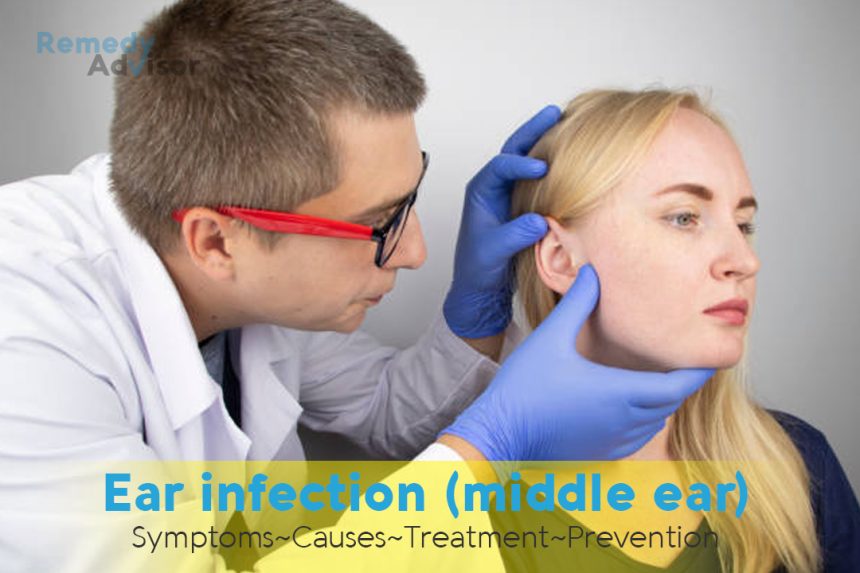What is it
Middle ear infections technically called otitis media are the most common cause of earache. They can occur at any age, though they are especially common among children up to age eight. Some children will experience these infections only occasionally, but in other children the infections can be chronic, occurring frequently and/or not clearing up readily.
Symptoms develop when the eustachian tube, which helps drain fluid from the middle ear into the nasal passages, becomes swollen and then blocked. This is often preceded by a cold or other upper respiratory infection. Fluid and pressure build up in the cavity between the eardrum and the inner ear, and die discomfort this causes can range in severity from a mild, dull ache that doesn’t seem to let up to an intense searing pain felt in front of, above, or behind the ear. Typically; the fluid that accumulates in the middle ear allows bacteria and viruses drawn in from the back of the throat to breed and cause infection. Sufferers often experience some temporary hearing loss.
Middle ear infections can afflict one or both ears, and they typically occur in the winter and early spring months, when respiratory tract infections are common.
Symptoms
- Congested feeling in the affected ear(s).
- A sharp or sudden pain, or a dull, continuous pain in the ear.
- Muffled hearing or temporary hearing loss.
- Pain when pulling on the earlobe.
- Fever (when bacterial infection is present).
- Discharge from the ear, headache, dizziness, and profound hearing loss are serious symptoms.
- In children: Young children may act extremely irritated and/or cry persistently as well as tug at their ears.
What causes it
Viral or bacterial infections of the upper respiratory’ tract, especially a cold or sore throat are often the cause of middle ear infections. Some allergies can also cause middle ear infections, as can an abrupt change in altitude.
The fact that the eustachian tube is smaller and more horizontal during early childhood, which helps spread infection from the upper respiratory tract to the middle ear, may be why children are more vulnerable to the infection.
What if you do nothing
Otitis media can clear up spontaneously within 10 days. Some infections can persist for weeks. Because the pain and discomfort are often too much to bear, treatment by a physician, supplemented by home treatment, is advisable. Also, in some cases an untreated ear infection can worsen to the point where the eardrum becomes inflamed or pressure causes the eardrum to rupture. Hearing loss is another possible complication, though it is usually reversible.
Home remedies
Whenever you (or a child) develop middle-ear symptoms, these measures can alleviate some of the discomfort. Nonetheless, you should also contact your doctor, since most middle ear infections can be cleared up quickly with medication.
Warm the ear
Hold a heating pad or warm compress to the ear.
Try baby oil
Warm the oil to room temperature and put a few drops into the sore ear. While this won’t treat the cause of the infection, it may offer some relief before you get to see your physician.
Raise your head when sleeping
Use pillows to keep your head comfortably raised. This will help drain fluids from your middle ear.
Relieve pain and fever
Over-the-counter anti-inflammatories aspirin, naproxen, and ibuprofen or acetaminophen may help relieve pain symptoms and fever. (Children should not be given aspirin because of the association with Reye’s syndrome.) Nonprescription ear drops may also bring some pain relief.
Take an over-the-counter decongestant
Decongestants can help shrink mucous membranes to open the eustachian tube and relieve middle ear pressure and discomfort. It’s important to follow warnings and instructions carefully when taking these medications. Some are made for adults and contain ingredients that are harmful when taken by children.
Sugarless gum may help
In a Finnish study, children chewing gum containing xylitol, a sugar substitute, had 40 percent fewer ear infections than those chewing regular gum. But kids in the study had to chew two pieces of gum five times daily quite a mouthful even if the child loves gum.
Prevention
It is usually not possible to prevent otitis media. But children who have recurrent infections may be able to take medications to prevent bacterial infections. You can also take steps to prevent ear pain at high altitudes.







